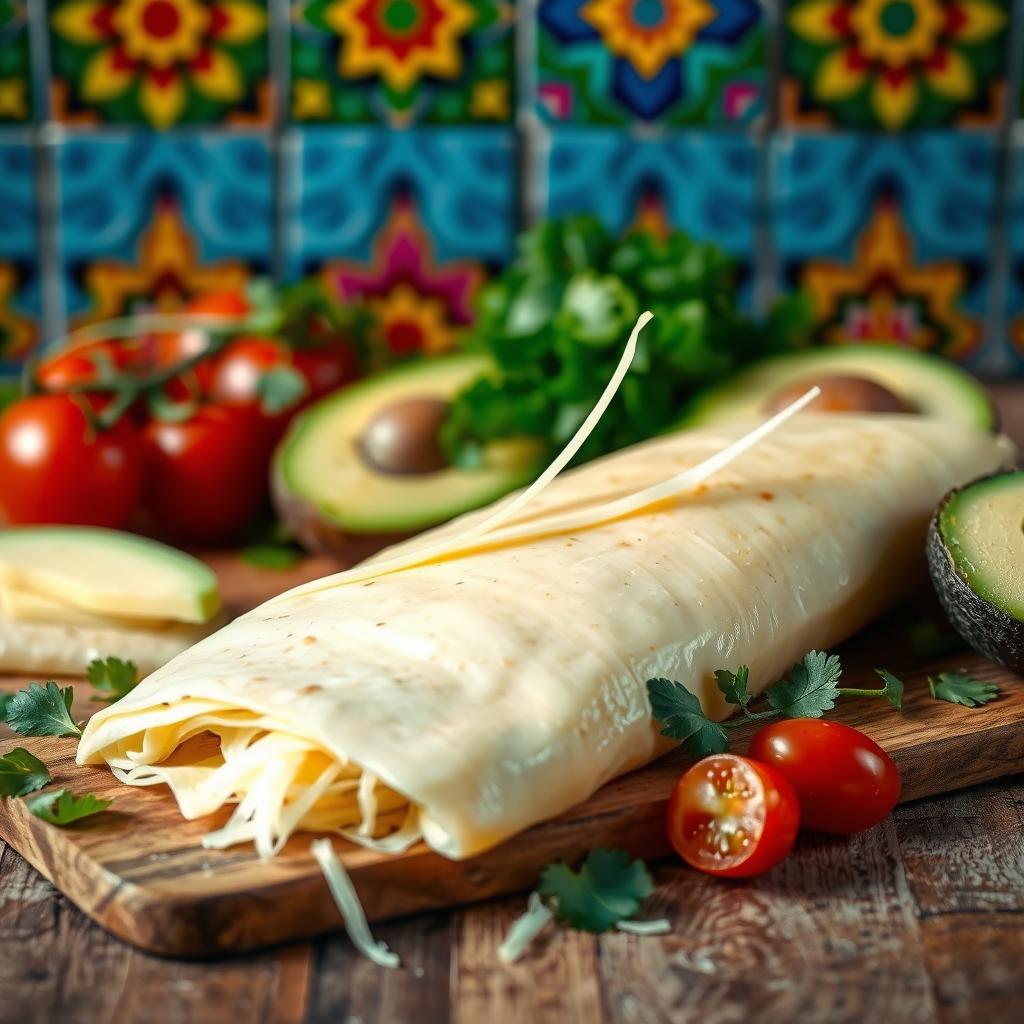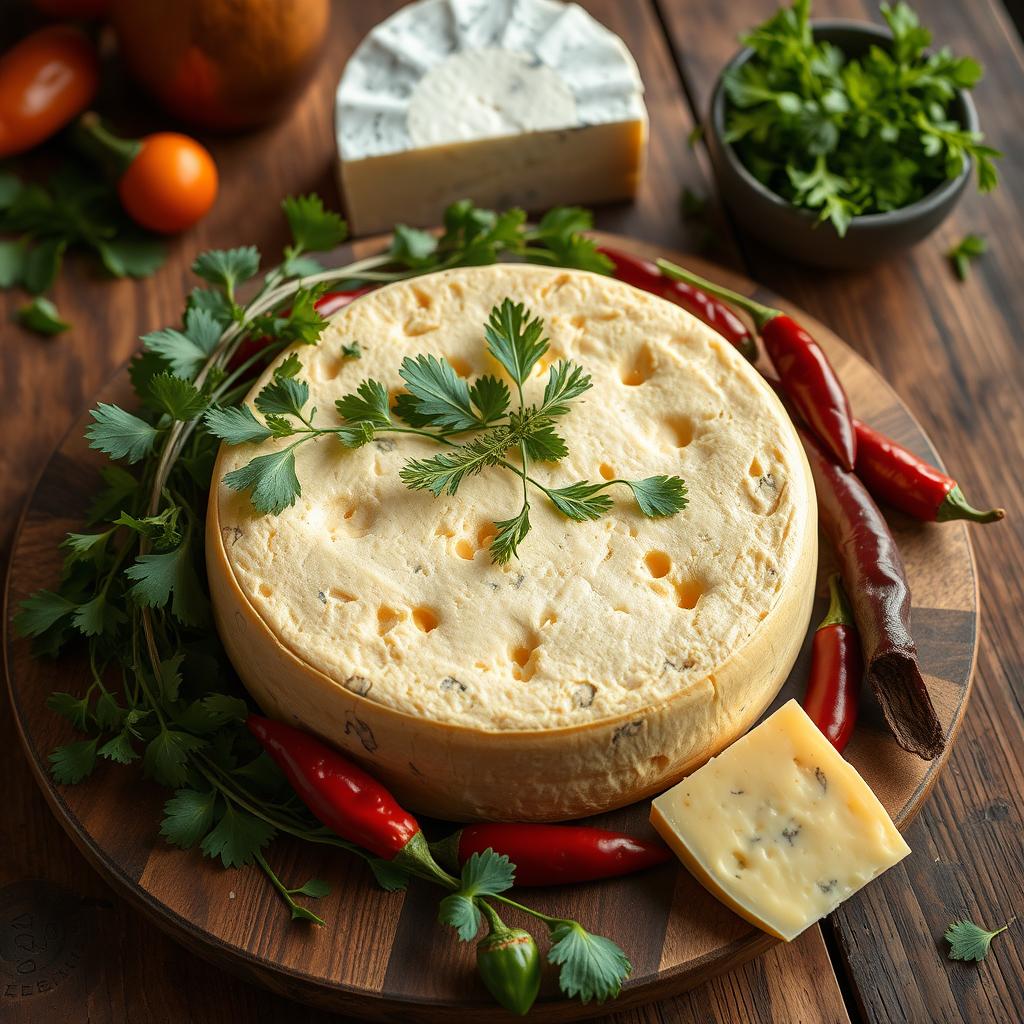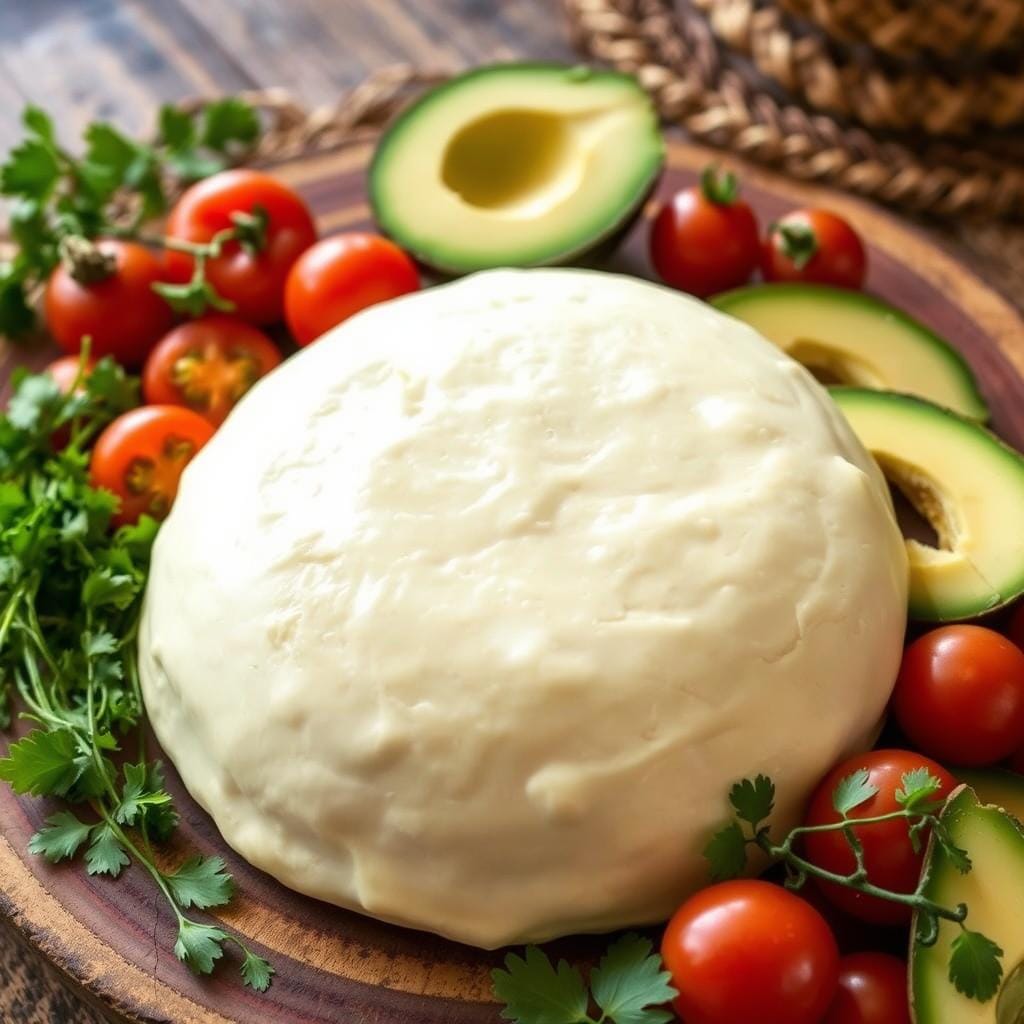Opening the fridge, you’re greeted by the warm, melted cheese smell. This is quesillo, a favorite Mexican cheese loved worldwide. Growing up in a Mexican-American home, seeing quesillo on the comal was comforting. The cheese’s stretchy, golden threads showed the skill and tradition behind it.
In this guide, you’ll learn to make traditional Mexican quesillo at home. You’ll understand its cultural importance and master the making process. Soon, you’ll be able to enjoy a taste of Mexico in your kitchen. Let’s start this journey to create this beloved cheese.

Key Takeaways
- Quesillo is a traditional Mexican cheese known for its stretchy, melted texture and mild flavor.
- Making quesillo at home allows you to recreate the authentic flavors and textures of this iconic Mexican cheese.
- The step-by-step process involves selecting the right milk, curdling and separating the curds, and stretching and shaping the cheese.
- Understanding the cultural significance and regional variations of quesillo can enhance your appreciation for this beloved Mexican culinary treasure.
- Proper equipment, safety considerations, and storage techniques are key to successfully making quesillo at home.
Understanding Mexican Quesillo and Its Cultural Significance
Quesillo, also known as queso blanco, is a beloved Latin American cheese. It’s a key part of Mexican cooking. Its history goes back centuries, deeply rooted in Mexican culinary traditions.
Origins of Traditional Quesillo in Mexican Cuisine
Quesillo started when Spanish settlers came to Mexico. They brought cheesemaking skills. Over time, Mexican cooks made it their own, creating a soft, mild cheese.
Regional Variations Across Mexico
- Every Mexican region has its own quesillo, showing the country’s diverse tastes and traditions.
- In Oaxaca, quesillo is soft and stringy, with a smoky taste. It’s used in Oaxacan-style queso blanco tamales.
- In Chihuahua, quesillo is creamy and mild. It’s great for melting and adding to Hispanic cuisine dishes.
Cultural Impact and Traditional Uses
Quesillo is more than just a cheese in Mexico. It’s a big part of Mexican culinary traditions. It’s often the star of special dishes and gatherings.
From melted queso blanco on tacos to Oaxacan quesillo-stuffed tlacoyos, it shows Mexican pride and identity.
| Region | Quesillo Characteristics | Traditional Dishes |
|---|---|---|
| Oaxaca | Soft, stringy texture, slightly smoky flavor | Oaxacan-style queso blanco tamales |
| Chihuahua | Creamy consistency, mild taste | Melted queso blanco for tacos, tlacoyos |
“Quesillo is not just a cheese – it’s a cultural touchstone, woven into the very fabric of Mexican identity and culinary heritage.”

Essential Ingredients for Homemade Quesillo
Making homemade quesillo, the prized Mexican fresh cheese, is simple with a few key ingredients. Choosing the right fresh cheese, dairy products, and artisanal cheese is key for the perfect taste and texture. Let’s look at what you need to make this beloved dish at home.
High-quality milk is at the heart of quesillo. It’s best to use milk from cows, goats, or a mix of both. The milk should be fresh, full-fat, and of the highest artisanal cheese quality. This ensures a rich, creamy base for your cheese. You’ll also need a coagulating agent, like rennet or vinegar, to separate the curds from the whey.
Seasoning is also crucial for quesillo. A pinch of salt brings out the natural flavors and helps preserve the cheese. You can also add spices and herbs for extra taste and a regional twist. Trying different salts, like Himalayan or sea salt, can add unique flavors to your homemade quesillo.
| Ingredient | Purpose |
|---|---|
| Fresh, high-quality milk | Provides the base for the cheese |
| Rennet or acidic coagulant | Separates the curds from the whey |
| Salt | Enhances flavor and aids in preservation |
| Optional spices and herbs | Adds additional flavor complexity |
With these ingredients, you’re ready to make your own delicious homemade quesillo. It’s a true celebration of Mexican culinary heritage.

“Quesillo is more than just a cheese; it’s a connection to the rich tapestry of Mexican cuisine and culture.”
Required Equipment and Kitchen Tools
Making the perfect quesillo at home needs more than just good ingredients. You also need the right cheese-making tools and kitchen equipment. This ensures a safe and successful cheese-making process. Let’s look at the necessary tools and the benefits of old versus new options.
Traditional vs. Modern Equipment Options
Traditional methods of quesillo making bring a sense of authenticity. But, modern kitchen equipment can make the process easier and faster. Here’s a comparison:
- Traditional: Stainless steel pots, wooden spoons, and cheesecloth for straining and shaping.
- Modern: Electric hot plates, food-grade plastic molds, and specialized cheese-making kits with all the necessary cheese-making tools.
Safety Considerations for Cheese Making
Keeping food safe is key when making quesillo at home. Make sure your workspace is clean, your hands are washed well, and all utensils are sterilized. It’s also important to control temperatures and store cheese properly. This prevents bacteria growth and keeps your cheese safe and quality.
“Successful cheese making requires attention to detail and a commitment to food safety. Investing in the right equipment and following proper hygiene protocols will set you up for delicious, worry-free results.”
Preparing Your Kitchen for Cheese Making
To make delicious homemade quesillo, your kitchen needs to be ready. Good kitchen hygiene and food prep are key. They help make sure your cheese-making setup is safe and of high quality. Let’s look at the important steps to prepare your kitchen for this fun cooking journey.
First, sanitization is crucial for cheese making. Make sure all your tools, utensils, and surfaces are clean and disinfected. Use a food-safe sanitizer to get rid of any harmful germs that could ruin your quesillo.
- Thoroughly scrub and sterilize all pots, pans, and cheese-making tools.
- Wipe down countertops, tables, and any other surfaces with a sanitizing solution.
- Keep your workspace clean and organized to avoid cross-contamination.
Then, focus on temperature control. Quesillo needs specific temperatures at different stages. Get a reliable thermometer to check your kitchen’s temperature and the milk and curd’s.
| Cheese-Making Stage | Ideal Temperature Range |
|---|---|
| Milk Preparation | 90-100°F (32-38°C) |
| Curdling and Separation | 95-105°F (35-41°C) |
| Stretching and Shaping | 120-140°F (49-60°C) |
With a clean, organized, and temperature-controlled kitchen, you’re set for making quesillo. These steps will help you make authentic, tasty Mexican cheese right at home.
Step-by-Step Quesillo Making Process
Making traditional Mexican quesillo at home is a fun journey. It starts with picking the right milk and preparing it. Then, you curdle and separate the milk, and stretch the cheese to get the perfect texture and taste. Let’s explore how to make cheese-making process at home.
Milk Selection and Preparation
The key to great quesillo is the milk. Use fresh, high-quality cow’s milk or a mix of cow and goat milk. Make sure the milk is clean and at the right temperature before you start milk curdling.
Curdling and Separation Techniques
Curdling and separating the curds from the whey is crucial. Heat the milk to the right temperature, then add a coagulant like rennet or citric acid. Watch the curds as they form and make sure they’re firm enough before moving on.
Stretching and Shaping Methods
The cheese stretching is what makes quesillo special. Scoop the curds and put them in hot water. Knead and fold the cheese until it’s smooth and stretchy. Shape it into the traditional form, and you’ll have delicious homemade quesillo.
Mastering quesillo-making takes time and patience, but it’s worth it. The homemade flavor and texture are amazing. Try different techniques and enjoy making this Mexican favorite in your kitchen.
Common Mistakes to Avoid When Making Quesillo
Making the perfect quesillo at home is rewarding. But, it’s key to know the common mistakes. These mistakes can ruin your cheese-making experience. By avoiding them, you can make better cheese every time.
- Failing to Properly Acidify the Milk: If the milk’s pH is off, it won’t curdle right. This can make your cheese taste bad and feel wrong.
- Overheating the Milk: Too much heat can burn the milk or make it feel rubbery. This is not what you want in your cheese.
- Insufficient Stretching and Shaping: Not stretching and shaping the curd enough can make your quesillo dense. It won’t be as good as it could be.
- Improper Storage Conditions: Wrong storage can cause mold or dryness. This ruins the quality of your cheese.
By fixing these common mistakes, you can make a delicious quesillo. It will taste like the real thing from Mexico. With practice and care, you’ll get better at making this cheese.
“The key to making exceptional quesillo is understanding the science behind the process and being willing to experiment until you find the techniques that work best for your personal preferences and kitchen setup.”
Storage and Preservation Tips
Keeping your homemade quesillo fresh and tasty is key. Follow these easy tips to make sure your cheese stays good for a while.
Proper Wrapping Techniques
Wrapping your quesillo right is important. Use airtight plastic wrap or wax paper to keep it moist. Don’t use foil or plastic bags as they can cause moisture and spoilage. Always label your wrapped quesillo with the date to keep track of freshness.
Temperature Control Guidelines
- For the best cheese storage, keep it between 40°F and 50°F (4°C to 10°C).
- Put your quesillo in the fridge right after making. Don’t let it sit out too long to keep it fresh.
- Check the shelf life of your quesillo. It should last up to 7 days if stored right.
By using these storage and preservation tips, you can enjoy your homemade quesillo longer. Its authentic flavors will last longer too.
| Wrapping Method | Recommended | Not Recommended |
|---|---|---|
| Material | Airtight plastic wrap, wax paper | Foil, plastic bags |
| Storage Temperature | 40°F to 50°F (4°C to 10°C) | Above 50°F (10°C) |
| Shelf Life | Up to 7 days | Less than 7 days |
Traditional Mexican Recipes Using Quesillo
the iconic Mexican cheese, is a star in many traditional dishes. It brings a creamy texture and unique flavor to favorites like quesadillas, tlayudas, and enchiladas. These dishes highlight Mexico’s rich culinary heritage.
Quesadillas, a beloved Mexican staple, get even better with Place the cheese between tortillas, add your favorite fillings, and cook until the cheese melts and the tortillas are crispy. Enjoy them with salsa or guacamole for a real Mexican taste.
For a taste of Oaxacan cuisine, try making tlayudas. These large, crispy tortillas are topped with refried beans, quesillo, lettuce, tomatoes, and more. The crunchy tortilla and creamy quesillo make for a delicious dish.

